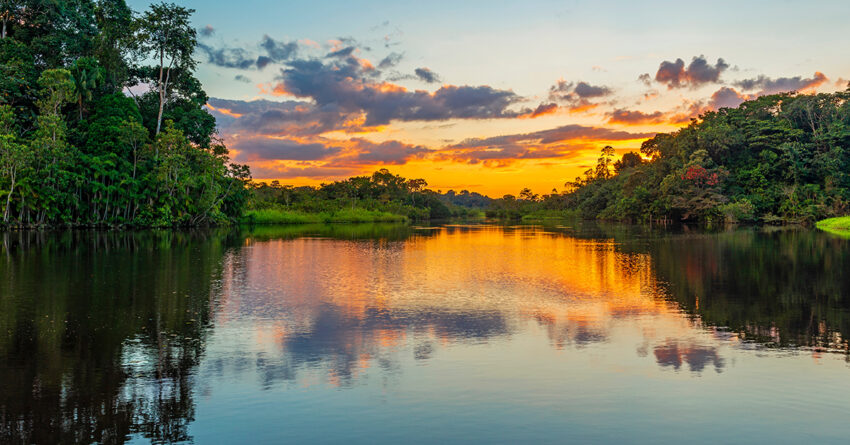When I am asked “What’s your favorite trip of all you’ve ever taken?” I am dumbfounded. But one that floats quickly to the surface of my mind, as one of the best trips ever, was a cruise on the Amazon River.
I had always wanted to see the jungle. From watching movies as a kid, I had thought of the jungle as being in Africa. When I went on safari to see the Great Migration in East Africa, the environment I found myself in was not a jungle at all. It was the high plains, the African savanna, which means “treeless plains.”
The actual savanna there is not strictly treeless plains. It’s more varied, with grasses and some outcroppings of trees and bushes here and there. Though it is equatorial, it is also high altitude and it gets quite cold at night. And though it might get hot in the daytime, it isn’t the heavy heat of the jungle. The high plains landscape in Kenya is more like Kansas than the jungle.
The jungle as portrayed in the movies was tropical rainforest, blazing hot, and humid, with tall trees and dense, nearly impenetrable undergrowth.
Much of the wilderness of the earth has been wiped out by human development, but one place you can still find the real primeval jungle is the Amazon. It stretches across a wide section of South America, over nine countries, including Brazil, Venezuela, Colombia, Suriname, Peru, Ecuador, Bolivia, French Guiana and Guyana, covering nearly 40 percent of South America. It’s the largest surviving rainforest on earth, and accounts for more than half of the primary forests found in the tropical regions around the world.
The Amazon is referred to as “the lungs of the earth,” because it’s the largest and densest clustering of trees left in the world. They pull carbon dioxide out of the atmosphere and breathe out oxygen, providing us with the privilege of breathing. The fertility of the land is demonstrated by the riotous growth on practically every inch of land. Nowhere is the raw survival power of biological life more impressive than in the Amazon jungle.

It’s the largest surviving tropical rainforest and, as such, it is even more rare and precious than it has ever been before. It’s worth a trip to the Amazon just to be able to breathe that oxygen-rich air from the area that produces more oxygen and less carbon dioxide than anywhere else.
I felt that the experience of the pre-human earth in the Amazon made a perfect bookend to my experience in New York, which represents more or less the extreme progression of urban industrialization, as well as post-industrialism. Traveling to the Amazon was to me like a visit to Eden, as far back in time as you could go.
The Amazon region is an ancient and modern marvel. It’s being aggressively attacked and destroyed piece by piece by profiteers, so who knows how long it will retain its power and beauty? But it is a mighty impressive phenomenon to experience while you still can.
The Amazon River is the largest body of fresh water in the world, larger than the Great Lakes in North America or Lake Victoria in Africa, or any other large body of freshwater you can think of.
The Amazon Basin, the area that is drained by that river, occupies half the area of the South American continent, including 75 percent of Brazil and parts of Colombia, Peru, Venezuela, Ecuador, Suriname and Guyana. The basin is almost as large as the continental United States. Amazônia, the Amazon jungle, is the world’s largest rainforest, covering 2.5 million square miles.
In filling out my bucket list, the Amazon moved ever closer to the top of the list. It seemed to me that I needed to fill out my travel experience by seeing what to me represented the primordial earth, the world before homo sapiens took control of most of it and began breaking it down.
Traveling to the Amazon to me was a chance to see as far back into our natural history as I was likely to ever be able to. A trip to the Amazon was not only a trip across a broad expanse of the earth, it was also a trip back in time. Much of the Amazon is still virtually untouched by human intervention.
Since the industrial revolution, industrialists have seen the Amazon as an incalculably rich treasure chest of resources. But the untamed Amazon has resisted them impressively. It’s never certain how long its resistance to exploitation will hold out, but it has beat the odds so far.
In 1851, Lieutenant William Herndon of the U.S. Navy wrote that the Amazon’s “capacities for trade and commerce are inconceivably great. Its industrial future is the most dazzling; and to the touch of steam, settlement and cultivation, this rolling stream and its magnificent watershed would start up into a display of industrial results that could indicate the Valley of the Amazon as one of the most enchanting regions on the face of the earth.”
But a century later the jungle had successfully repelled most of the efforts to penetrate it or control it. The rubber industry came, becoming one of the biggest money-making enterprises ever, and then packed up and moved the industry to Indonesia, where it was easier.
In 1961, Peter Matthiessen wrote in Cloud Forest, “The Amazon remains as sullen and intractable as it ever was; indeed, it is startling to find how exactly the descriptions of Herndon and such contemporaries as the great naturalist H.W. Bates and the botanist Richard Spruce correspond with the appearance of the river as it is today. The few large towns excepted, the traveler on the Amazon sees almost precisely what these men saw a century ago.”
My trip was to the Brazilian Amazon. I would happily go back and do it again, but I would also love to visit the part of the Amazon that is further upriver, closer to its source, the part in Peru. And recently I discovered an operator of luxury river cruises to that area. It’s called Jungle Experiences, based in Lima, Peru.
The Jungle Experiences product is a little more high-end than what I experienced. The company offers three riverboats, all different, to accommodate a range of demographic differences in preferences and prices.
Zafiro, which translates to “sapphire,” is the line’s most luxurious boat, a five-star craft with a capacity of 40 passengers, and ceiling-to-floor windows that minimize the separation from the environment. It has three decks. Suites on the second deck have private balconies. Indoors it’s air-conditioned, a necessity in the Amazon.

The boat has a number of high-end amenities such as an exercise room and a spa offering massages, an outdoor bar, a jacuzzi, and a reading lounge. TVs and wifi are not included, it’s too remote for that stuff. The vessel features a refined cuisine made of local ingredients.
Next is La Perla, which you probably guessed is named after a pearl. It’s the line’s four-star experience. And finally is Amatista, the three and a half-star experience, with things scaled down accordingly from the top-end Zafiro.
The experience offered is similar in many ways to the service I experienced on the Brazilian Amazon. Rosana Guinea, the company’s sales and marketing director, described it as “the perfect combination of adventure and luxury in the middle of the Amazon.” And from the photographs, the stats and descriptions, and drawing on my own experience in the Amazon, I can confirm her claim.
Jungle Experiences offers trips that are eight days and seven nights, and trips that are five days and four nights.
The price includes all meals, all excursions and jungle walks—two or three a day. Beer wine and domestic liquor are included. Imported liquors are extra. Nothing wrong with a week of pisco sours.
Daily excursions usually include a trip in a skiff, to a landing point and a jungle walk with a naturalist guide. Kayaking is also available.
The wildlife is the highlight of any Amazon trip, with a stunning array of wildlife, including dolphins, caiman, giant parrots and smaller parakeets, sloths and howler monkeys that you can hear doing their morning rituals, even when they are not within sight.
The itineraries include meetings with local communities, during which there are opportunities to learn about local people, and to buy locally made crafts.
The trips depart from Nauta, Peru, a port that is close to Iquitos, the capital city of the Maynas province, and near the Iquito airport.
For more information on Jungle Experiences, see https://www.junglexperiences.com/.

David Cogswell is a freelance writer working remotely, from wherever he is at the moment. Born at the dead center of the United States during the last century, he has been incessantly moving and exploring for decades. His articles have appeared in the Chicago Tribune, the Los Angeles Times, Fortune, Fox News, Luxury Travel Magazine, Travel Weekly, Travel Market Report, Travel Agent Magazine, TravelPulse.com, Quirkycruise.com, and other publications. He is the author of four books and a contributor to several others. He was last seen somewhere in the Northeast US.



